1
HOME > Events >
NEW YORK MEN’S DAY SPRING/SUMMER 2019 ROUNDUP
STUDIOS DEDICATED TO DESIGNERS' PRESENTATIONS AT CREATIVEDRIVE
Written by Ivan Yaskey in Events on the 11th July 2018
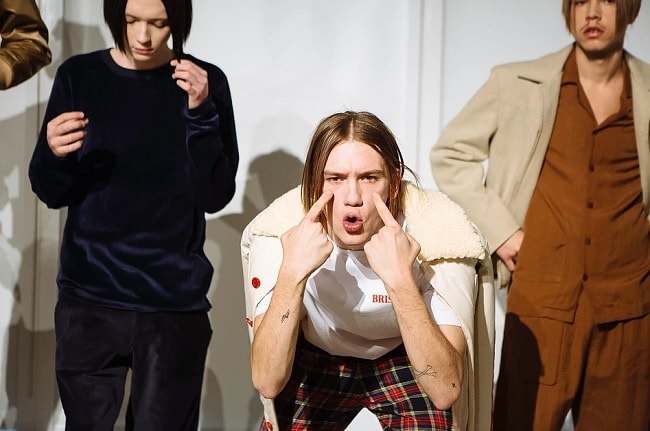
London has MAN, and New York Fashion Week: Men’s has New York Men’s Day (NYMD). The two give a platform to emerging designers to showcase their latest collections, and in NYC, NYMD kicks off the week-long event that eventually sees bigger names presenting their SS19 offerings. We received an invite and headed over to CreativeDrive on the edge of the city’s Financial District. If you’ve ever been in the area, it’s one of the many larger office buildings down the street from the Staten Island Ferry. The setting – a row of studios, each dedicated for half the day to one designer, down to the theme and inspiration – seemed equally as nondescript, save for the circus-themed booths you passed upon entering, until you started watching the presentations themselves. The morning saw six brands present, and the late afternoon shifted to five more. If the day could be summed up with one phrase, it’s this: Menswear has reached the point of fluidity that streetwear and suiting can coexist in the same literal space, without either half seeming like an oddity. It’s a far smoother dichotomy – almost boundary less, even – than what you see from similar women’s presentations and reflects where fashion is collectively progressing: To the point where there’s no true formality, leisure gets taken seriously and ironic statements, in losing their edge seem accessible. Here’s a rundown of each of the day’s presentations.
Sundae School
A fairly new brand and another first-time presenter, Sundae School considers itself a smokewear label that delivers functional style for modern-day cannabis enthusiasts. Dae Lim, who did stints at VFILES and McKinsey & Company and studied applied mathematics at Harvard, puts both parts of his background to use here. If you’re of a certain age, or at least grew up in certain urban areas of the US, you know what weed-influenced fashion can be: graphic tees with cartoon characters toking it up, tacky platinum necklaces with cannabis leaf pendants, or cheap Rastafarian-inspired digs. Thankfully, you won’t find any of that here, and unless you spotted the 'Smoking Chills' tee or the fan painted with 'Smoke Sessions, Not Jeff Sessions,' you might not have gotten the reference. Lim’s mathematics background emerges through wider, more spacious silhouettes, cut with angles or asymmetrically. Some appear robe-like, and others as casual suiting tied across the front. And, aside from the occasional pop of blue, all of the shades and patterns subtly hint at marijuana use: light and dusty green shades that could look militaristic, if they weren’t the same colour as a joint; brown hues reminiscent of rolling papers; and a blue and white print similar to Dutch pottery, likely referencing Amsterdam coffeehouses. Yet, amidst all this, Sundae School makes one thing clear: Their clothing’s made for chilling out, no matter if you’re stoned or sober.
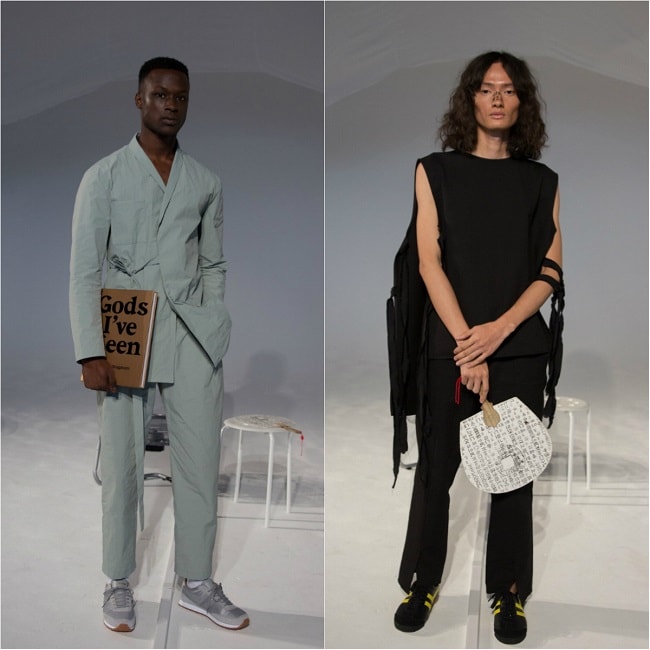
AGENT
Admiration for 'dad fashion' tied together the morning’s presentations, with AGENT taking a literal approach. Presenting at NYMD for the first time, the brand – founded by Terrence Williams, who previously worked at LA footwear brand Creative Recreation, and Joshua Fronda, from the UK and a former designer for Clarks, Puma, and Lacoste – captured that laidback, don’t-care effortlessness through an assortment of slouchy and cropped silhouettes: baggy, pleated trousers, joggers tapered above the ankle, stonewashed jeans, unstructured blazers, bombers cut above the waist and longer polos. At a glance, the accessible designs made almost everything ideal for everyday wear. Yet, that’s too simplistic of a synopsis. The expected and direct established clear-cut boundaries that allowed Williams and Fronda to play around with textures, silhouettes, and symbolism. For one, materials stretched from shiny nylon through knits and what appeared to be slightly rumpled cotton blends. As well, the presentation went for unisex territory, with a handful of female models sporting wider-cut, athletically styled garments. Then, while the stonewashed jeans and polos played up the 'dad relaxing on the weekend' angle, a handful of models with silver chains around their necks flipped the script and perspective: You can just as easily wear these as classic urban gear as you can modern-day, ironic streetwear.
Descendant of Thieves
Sometimes, there’s no need for allusions. Descendant of Thieves, a NYC-based brand started by Matteo Maniatty and Dres Ladro in 2009, designed its collection around the party culture of Tulum and the Mayan Riviera. Bright colours and Hawaiian-style prints fleshed out the region’s leisurely atmosphere, illustrating why youth from the US and Europe flock there for spring holidays. Within this visual setting, they hinted at the Mexican location with Day of the Dead motifs and cut silhouettes that you’d actually wear, should you be heading down to spend time on the sand to listen to the chill sounds of a big-name DJ. With a literal beach scene serving as the presentation’s backdrop, rows of models rotated positions to highlight the collection’s styles. Nothing here read as serious or uptight, from the rolled chino shorts to the unstructured blazers, bombers, and button-up short-sleeve shirts. Instead, Descendant of Thieves made a very strong case for pattern clashing: It wasn’t unusual to see florals and stripes alongside a vibrant solid hue. And, vibrant they could be, from saturated yellows and pinks to solid gold. Yet, with menswear gravitating toward such seemingly unfamiliar territory, Maniatty and Ladro created one of the day’s more forward-thinking yet still practical lines.
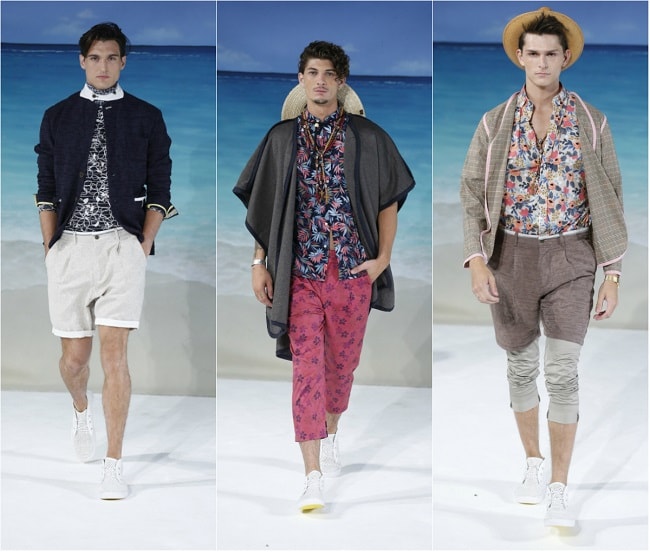
Limitato
Another first-time presenter, Limitato is one of those brands that seems simple on the surface – much of their SS19 presentation appeared to be photographic placement prints – but goes far deeper. Specifically, designers Gustave Peterson, Emrik Olousson, and Alex Ulvsgard go by the philosophy that art should transform culture, and thus, they strive to blend fashion with hospitality and current affairs. For the actual clothes, the team gathers images from artists and photographers and then converts them into “Limitato Wearable Art.” With these points in mind, classic rock music framed their SS19 collection, down to the drum set, amplifier, and electric guitar in the background and a table to the side featuring a book open to a photo of the Rolling Stones. Images of lips established a clear allusion to the seminal blues rock band, while a placement print of Marilyn Monroe more subtly emphasised that “live fast, die young” philosophy that’s characterised decades of rock music. Complementing the sweatshirts and tees, skinny velvet trousers with visible metallic ankle zippers could’ve easily been worn by Mick Jagger back in the ‘70s.
David Hart
Since graduating with a BFA in fashion design in 2004 and starting his own label in 2009, David Hart has been named a CFDA/Vogue Fashion Fund finalist and one of GQ’s Best New Menswear Designers in America, and was nominated for The International Woolmark Prize in Menswear. The designer, who spent time working under Anna Sui, Tommy Hilfiger, and Ralph Lauren, envisioned his line as historically influenced, nostalgically inclined apparel that’s still accessible for the modern gentleman, and with this Watergate-themed SS19 presentation, each of those influences came through. For the only suiting-focused morning presentation, Hart made his 1970s setting clearly evident. Wide-lapeled styles – some solid and others sporting a bold pattern – could’ve been worn at the office during the period – but wouldn’t have been out of place during that prom scene in Carrie, either. Although a desk, typewriter, and tape recorder hinted at the theme, garments straddled the line between clearly masculine and intentionally feminine, with seahorse brooches reminding the audience of the way gender roles can be flipped naturally. Specifically, suiting and colour-blocked polo shirts established that masculine foundation. Yet, even something clearly meant for the male form can still reflect the feminine: Here, that came through patterned neck scarves, pleated, flared trousers, large velvet ties mirroring a pussy-bow blouse, and glittering brooches.
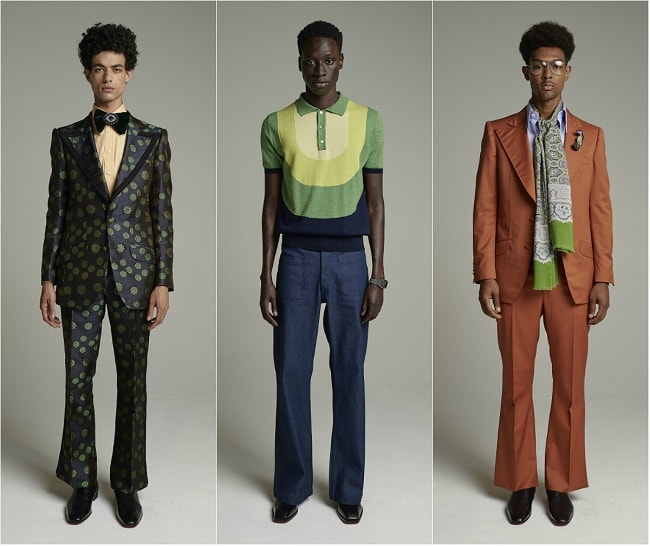
Bristol Studio
Recipients of Gen Art’s 2016 menswear designer of the year award, designers Luke Tadashi and Tommy Nowels seem to understand that athleisure’s turning into a well-worn, if not tired, path of lazy sweatshirt and jogger silhouettes. It’s gotten to the point that we’ve seen it all before, and the actual athletic elements seem to fade into the background, if not get pushed aside entirely. Thus, Bristol Studio’s SS19 collection almost reversed that familiar combination, hammering home actual athletic pieces and infusing, if not draping, them in higher-end style. Aspects like oversized basketball shorts, drawstring sweatpants, a track jacket, dad trainers, pulled-up white socks, and a pullover with Adidas and Bristol Studio logos, most in neutral hues, looked more appropriate for an evening training session. But, Tadashi and Nowels juxtaposed that with unusual pops of colour – dusty pink and yellow-orange – and the occasional strictly fashion piece, such as a see-through jacket or pleated trousers. As such, rather than treat activewear like a tossed-off trend of the day, Bristol Studio knows that such pieces operate on two levels: Purely practical and clothing that’s meant to be relaxed in.
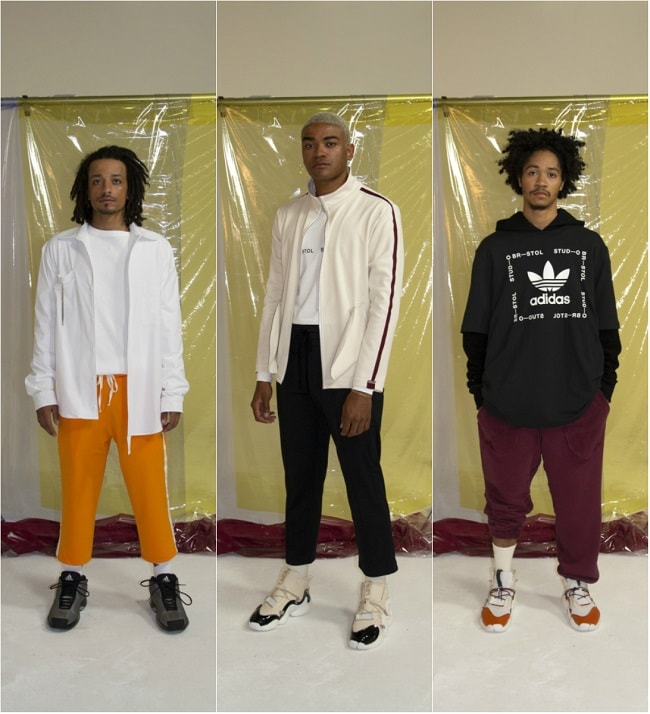
HBNS
Known for its denim, HBNS is the brainchild of self-taught designer Akio Mitobe, who launched the brand back in 2006. While made in Japan, HBNS reflects Mitobe’s love for Americana and vintage styles, with emphasis placed more on work, military, and surf influences. For its first NYMD presentation, HBNS set the stage with elements of a construction site: models leaned against wood beams, metal pipe framed the top and sides, and a couple of step ladders made it seem like renovations were about to start. Thus, within this more literal setting, Mitobe tread into familiar workwear territory: Slim, structured denim speckled with splatter paint, pleated trousers reminiscent of something Dickies might produce, and faded ripped materials hinting at the wear resulting from everyday use on the job. But, knowing where its strengths lie as a denim brand, HBNS didn’t replace the familiar woven material with cotton duck. Instead, a series of two-piece ensembles expanded upon what might have been dismissed as a Canadian tuxedo with bright prints and colours: Hawaiian patterns, tye-die reminiscent of a Firecracker ice pop, and soft dandelion yellow. After all, if a cotton or linen-blend short suit’s a viable option for dressing up in summer, why can’t you do the same with denim?
Vanessa Zhang
Capturing the NYMD’s concept on a microcosmic level, Vanessa Zhang, a self-described “fashion incubator,” showcased collections during the afternoon program from three emerging designers: Kevin Ng, of Unawares, known for a minimalist aesthetic; Jiahao Wan, a recent graduate of the Parsons School of Design, who put together a collection inspired by artificial intelligence and Y2K culture; and Han Xi, a 2017 graduate of the University of the Arts London, who put together a collection inspired by light, curve, and colour. Zhang’s efforts, with this presentation and beyond, offer the designers resources to grow their businesses globally. Likely as a result of this approach, the presentation lacked the cohesion present in others. Boxy silhouettes, long coats, high-waist trousers, geometric colour-blocking, and overlapping tiered materials formed the foundation for many pieces on stage. Yet, from here, we were introduced to what seemed like a rain motif: transparent PU materials juxtaposed with a linear print reminiscent of falling precipitation. As well, workwear hints came through, with double flap chest pockets added to blazers. And, as one smaller element, that oversized office garb look sported by a few post-Soviet fashion brands also made an appearance. Amidst all this, models held circular-shaped handbags that, with a long top strap, resembled canteens.
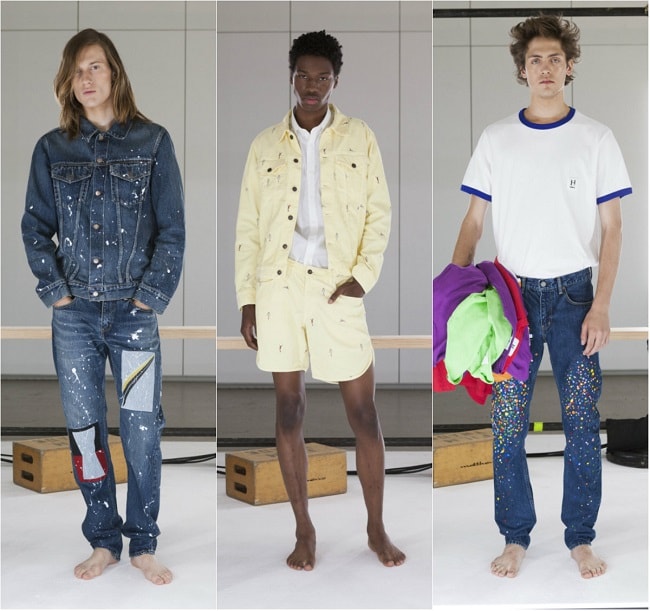
Krammer & Stoudt
From Hollywood to Venice Beach, California might as well be Americana in concentrated form. While based on the East Coast and manufacturing their garments in New York, Krammer & Stoudt, under the direction of Michael Rubin, looks toward classic SoCal subcultures and the mysterious desolation of the Southwest. Krammer & Stoudt’s SS19 collection reflected this split. Playing throughout parts of the presentation, Foster the People’s 'Pumped Up Kicks' established the West Coast admiration, while a couple of models displayed some Bone Breaking moves – a dance style originally from Brooklyn. Style wise, draped silhouettes in neutral hues seemed reminiscent of NYC’s Public School, and at the same time, aspects like camp collar shirts and souvenir jackets pulled directly from mid-century Hollywood. In between, short suit sets, cropped trousers, bucket and wide-brimmed hats captured year-round warm-weather style from a more sophisticated angle – something that’s only truly possible when you’re hanging around Los Angeles.
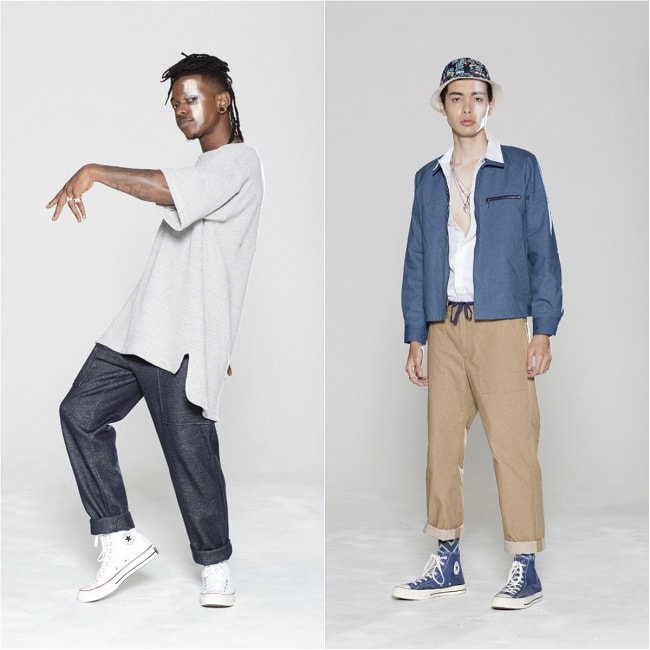
TAAKK
Already presenting at Paris and New York and a recipient of the Tokyo Fashion Award, TAAKK considers the role of geometry and colour in producing fashion. Likely as such, the brand’s SS19 presentation made use of the studio space specifically for this purpose. While plastic bags, all printed with the fashion brand’s logo, framed part of the doorway, bright light – taken to an extreme through the use of photography diffusers – illuminating the space, which further featured a white painted floor. The press could walk around the models, who had been spaced throughout the room, rather than typically put to one side or on a stage. Within this setup, TAAKK appeared to play around with perception; firstly with a pattern reminiscent of a blotchy, brush stroke-heavy impressionistic painting. With warmer hues, the combination mirrored a sunset; with blue-based or darker shades, by contrast, it took the form of clouds or undulating ocean waves. On denim, similar brush strokes looked like careful, deliberate paint splotches. Beyond this element, TAAKK designed multiple jumpsuits and two-piece ensembles out of a windbreaker or shell-like material and what appeared to be thicker polyurethane. If they were designed out of cotton or polyester, you’d think nothing of it – or maybe perceive the collection as high-concept streetwear. But, with the materials’ supposed flimsiness and synthetic nature, such mundane shapes start to seem ephemeral or purposefully engineered – much like those plastic bags.
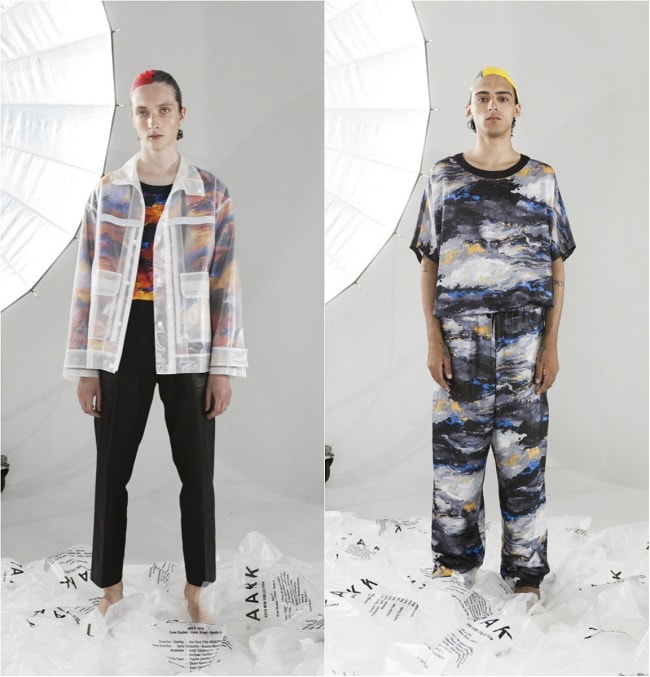
This is Sweden
Ana and Pablo Londono created This is Sweden in 2013 as both a political statement and future-envisioning collection, oftentimes with both concepts overlapping each other. Influenced by how, as children, they discovered how one’s appearance could play a role in an observer’s attraction or loathing, and further by how the Swedish flag, at one point, symbolised the country’s right-wing racist attitudes. The result blends Swedish culture and symbols, including those familiar colours, with tech materials and high-quality construction. Out of all the afternoon’s presentations, This is Sweden appeared the most minimal: Four models stood on individual platforms, while additional photos of the collection covered the walls. A quick look made the line seem denim oriented: Matching jeans and cropped jackets in bright yellow and traditional deconstructed materials. Yet, nearby, camouflage patterns created a contrast amongst the fluidity of these average streetwear silhouettes: The universality of denim, versus the militaristic, if not right-wing symbolic, print. The surrounding photos – perhaps, if you were being dismissive, as a way to use fewer models – essentially brought the extremes together. The models photographed sported similar rayon bomber jackets, but if you studied the pictures for even a moment, you would’ve noticed they weren’t the usual cadre of youthful faces. Rather, a much larger demographic – young and old, male and female, and encompassing multiple ethnicities and religions – indicating that casual fashion is what unites us all.
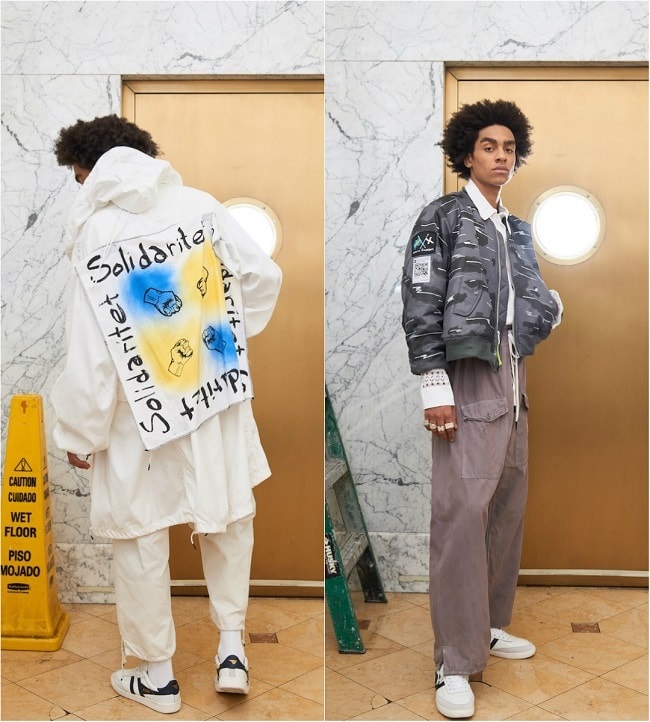

Trending
2
3
4
5
6
7
8
9
10










